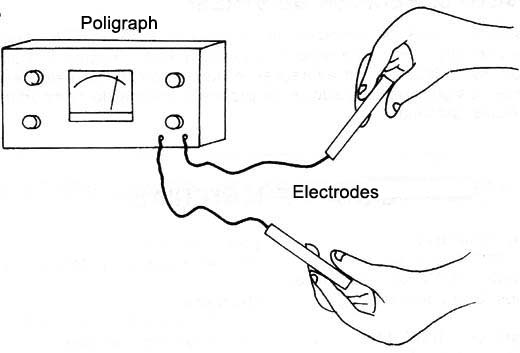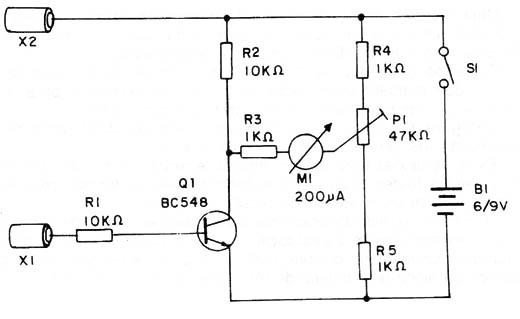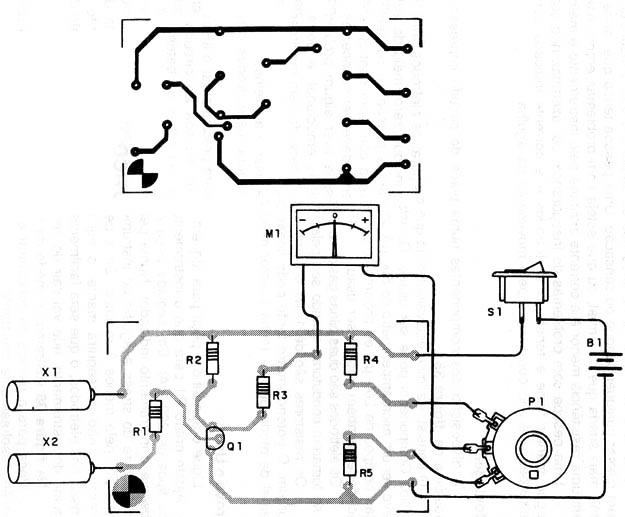One way to detect this state of stress or tenseness is to monitor the skin resistance, which can be easily done with the help of the device we will describe.
We can say that it is a fairly simple and sensitive polygraph, which also serve as a lie detector and to accuse acupuncture points if the electrodes are modified.
In Figure 1 we how a polygraph is used to detect a person's skin resistance variations.

These variations can indicate both emotional stresses associated with a lie (lie detector) as they can help in the concentration or to measure the state of tension or stress.
The circuit basically consists of a sensitive Wheatstone bridge with a common transistor and an indication of skin resistance being provided by a common milliammeter.
It can be powered with 4 small batteries or one 9 V battery and its consumption is very low.
How it works
In Figure 2 we have the complete diagram of the Stress Meter.

An indicating instrument, preferably of the type containing zero at the center of the scale (like in the previous design) is placed in a Wheatstone bridge in order to monitor its balance.
One of the bridge branches contains a common bipolar transistor element that serves as an amplifier for the current which runs through the test electrodes.
These electrodes are held by the person who want to test his/her stress, so that a current flows through the skin and the body.
This current is of the order of millionths amp, very weak to cause any damage or sensation. One does not feel anything.
However, the intensity of this current will depend on the person's skin resistance and the way he/she handles the electrodes, which allows the evaluation by the stress state. To feed it with batteries, the current will be in the ampere millionths of order, which is insufficient to cause any shock or feeling.
A tense person who has the sweatier hands than normal, i.e., who has emotional problems, has a lower resistance and the current indicated by the instrument is higher.
A person with security problems, for example, cannot firmly keep the voltage on the electrodes and the indicated current undergoes variations which are observed by movement of the needle.
Assembly
The arrangement of components on a printed circuit board is shown in Figure 3.

The transistor admits equivalent, as any general purpose NPN can be used.
The instrument M1 should preferably be a milliammeter of 50-0-50 µA with zero at the center of the scale, but the types of 200 µA or thereabouts, that are easily found, can also be used.
The electrodes are two old batteries with a shaved external ink so as to become conductive when safe in the hands of the person being tested.
The resistors are 1/3 W or higher and the switch S1 is the common type. The pot can be both linear and log in and will be fixed on the board so that it has access through an external button.
Test and Use
Turn on the device and ask someone to hold the electrodes firmly. Adjust then P1 so the instrument indicates zero (in the middle of the scale in the types of 200 µA). Then ask the person to focus and observe the indicator device.
In a person with a good emotional control and free from stress the needle of the device should remain stationary for at least 3 minutes. If the person has a stress problem he/she, cannot keep the emotional balance and thus the voltage at the electrodes, which is easily observed by the needle movement of the instrument that will come out of zero.
Ask the person to focus and hold the electrodes with an absolutely constant tension.
Whenever you test a new person you will need to reset the instrument, both to adapt the characteristics of the person to the circuit as well as to compensate for the wear out of batteries or battery.
Semiconductors:
Q1 - BC548 or equivalent NPN transistor for general purpose
Resistors: (1/8 W 5%)
R1, R2 - 10 k Ω - brown, black, orange
R3, R4, R5 - 1 k Ω - brown, black, red
P1 - 47 k Ω - pot
Miscellaneous:
X1, X2 - Electrodes - see text
S1 - A single switch
M1 - A microamperimeter - see text
B1 - 6/9 V - 4 batteries or a battery




